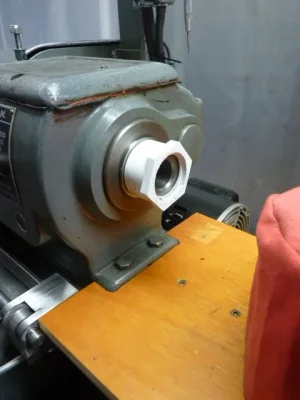curmudgeon
(Steve)
I want to cut internal threads to a shoulder using my Grizzly G0602 10x22. They'll be at least 1 1/8", maybe 1 1/4" diameter and almost 1/2" deep
Joe makes it look easy -
But, he also says don't try cutting in reverse on a lathe with a screw on chuck.
My lathe has a screw on chuck with a locking device to prevent the chuck from threading off when used in reverse.

Is it safe to cut internal threads in reverse on my lathe when the chuck lock is installed?
For this project it doesn't matter if I cut left hand or right hand threads, but I haven't started the project to install tumbler gears yet so I can't thread left-to-right with the spindle spinning forward.
Are there better ways to cut internal threads to a shoulder (better than Joe? impossible...)
As an alternative, would it be reasonable to add a microswitch to a carriage stop to kill the motor as the tool approaches the shoulder? Without a brake, the spindle and carriage would coast to a stop - if I set it to stop at the right spot with no load it should stop a bit short of crashing when loaded.
Along the same idea, are there carriage stops that can reliably disengage the half-nut at a set position? I'm thinking of a physical linkage, not a switch with actuator.
Please share your wise ideas, and help me avoid folly.
Joe makes it look easy -
My lathe has a screw on chuck with a locking device to prevent the chuck from threading off when used in reverse.
Is it safe to cut internal threads in reverse on my lathe when the chuck lock is installed?
For this project it doesn't matter if I cut left hand or right hand threads, but I haven't started the project to install tumbler gears yet so I can't thread left-to-right with the spindle spinning forward.
Are there better ways to cut internal threads to a shoulder (better than Joe? impossible...)
As an alternative, would it be reasonable to add a microswitch to a carriage stop to kill the motor as the tool approaches the shoulder? Without a brake, the spindle and carriage would coast to a stop - if I set it to stop at the right spot with no load it should stop a bit short of crashing when loaded.
Along the same idea, are there carriage stops that can reliably disengage the half-nut at a set position? I'm thinking of a physical linkage, not a switch with actuator.
Please share your wise ideas, and help me avoid folly.



